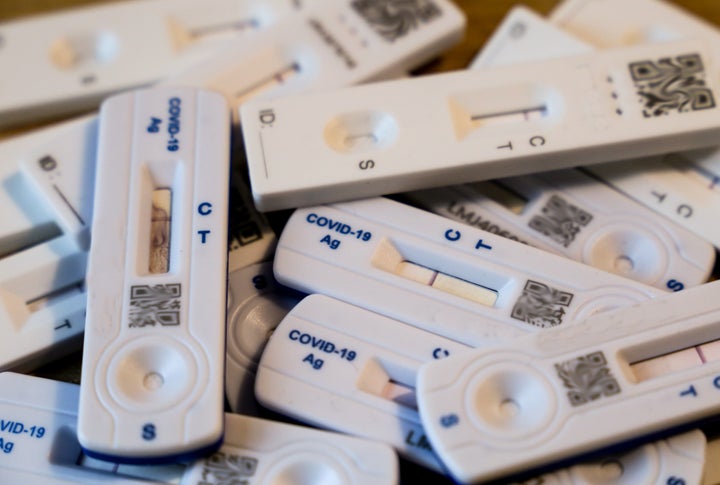
As of Friday, Omicron cases have risen to 11,708, which means it’s very quickly spreading around the country.
That might mean you’ve been in close quarters with someone who has tested positive for coronavirus.
The first port of call if you’ve been exposed to someone who has Covid is to test with lateral flows tests (LFTs) every day for a week. If you’re socialising before Christmas and want to keep yourself and others safe, you may also be testing with lateral flows before meeting anyone, as per government advice.
Lateral flow tests are designed to be taken if you don’t have any symptoms of coronavirus. As soon as you start showing any symptoms, you need to book a PCR test to get official results, all the while isolating.
But, if you don’t have symptoms, could you still have asymptomatic Covid while carrying the Omicron variant? And can you trust lateral flow tests to pick up the Omicron or even Delta variant of Covid before you know you have it?
Do lateral flows detect Omicron?
The good news is, yes, the UK Health Security Agency has tested the lateral flow equipment and found that it does pick up Omicron as well as it picked up other Covid variants such as Delta.
In a report published December 17, it said: “UKHSA has performed an initial laboratory evaluation of the current lateral flow devices (LFDs) for COVID-19 in current use by NHS Test and Trace. Preliminary laboratory data assess these
devices as detecting Omicron. Initial data from contrived samples indicate a comparable sensitivity to that observed for previous strains of SARS-CoV-2 including Delta, which has been the predominant strain in the UK from May to December 2021.”
We spoke to Professor Paul Hunter, an expert in infectious diseases at the University of East Anglia, who says that, broadly, we can trust LFTs.
“Research shows that these devices as effective at detecting Omicron and Delta,” he explains. “We haven’t seen the data so not sure for certain how strong this conclusion is. But in general LFTs are thought to be pretty good at detecting positives in symptomatic people with higher viral loads.
However, there is a catch. “For people, with low viral loads the sensitivity is not so good,” he adds. The advice is therefore as follows. “If you have symptoms (whether classic or more cold-like symptoms) and test positive – ie. likely to have Covid infection – get a PCR and self-isolate,” says Professor Hunter.
“If you have symptoms and test negative – repeat the test a few hours later.
If you still test negative with LFT, either you don’t have Covid or you do and you have a low viral load in either case you are not much of a risk to others. If symptoms persist, check again in a day or two.”
How quickly will an infection show on a lateral flow?
If you’re at a busy event and want to test whether you’ve picked up a viral load the next day before meeting or socialising with anyone else, it may be too soon for a lateral flow to pick up whether you’re positive.
This is because rapid antigen tests are less sensitive than PCR tests and require a higher viral load to record a positive result.
Because of this, it’s possible to get a false negative from a lateral flow test – the tests often only identify people during their most infectious period (people are infectious two to three days before symptoms start to show and are most contagious in the first 10 days of catching the virus).
However, that doesn’t mean lateral flow tests are pointless. As the government website states: “They can find positive cases with high levels of virus that are easy to transmit to others, helping to intercept and reduce further infections.”
The best way to use lateral flow tests effectively is to ensure you’re testing often – especially if you’re planning to socialising frequently during the festive period.
And remember, if you’ve got Covid symptoms or you’ve been exposed to someone who has tested positive, you should order a PCR test through the NHS website and self-isolate until you get the results. And if the results are positive, you will need to self-isolate for 10 days from the start of your symptoms.
Where can you get a lateral flow test?
LFTs are usually available to order for free via the NHS website to be posted to your home. However, due to high levels of testing, stocks are often unavailable.
A government spokesperson insisted to BBC Newsbeat there is no shortage, but if you’re struggling to order online, your best bet could be a pharmacy: big chains including Boots and Lloyds, as well as some local pharmacies, are giving out test packs for free.
If tests are available via your work, school, college or university, you can also use these routes. Some community centres such as libraries and mosques, plus PCR testing sites, also stock lateral flow packs.
Each pack contains seven tests, one for each day of the week, and you may be able to collect two packs at a time to tide your over the Christmas period.